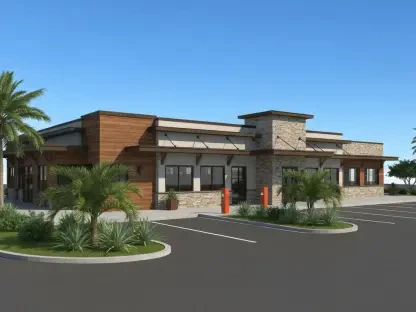The fast-food industry, deeply woven into the fabric of American culture, has undergone significant transformations over the decades. From its nascent stages with innovators like White Castle to a prolonged period of stagnation, the sector recently experienced a remarkable surge in productivity, primarily spurred by adaptations necessitated by the COVID-19 pandemic. This article explores the industry’s historical context, stagnation in productivity, and the impressive improvements driven by recent innovations.
Pioneering the Fast-Food Model
White Castle, established in 1921 by entrepreneurs Walter “Walt” Anderson and Billy Ingram, is often celebrated as the trailblazer of the modern fast-food industry. The founders introduced standardized practices and menu items, creating a replicable model that set the stage for the growth of future chains. Innovations such as square-shaped burgers allowed for maximum grill utilization, significantly boosting kitchen efficiency. Additionally, limiting the menu options streamlined the food preparation process, making service faster and more reliable. These early advancements set benchmarks in productivity that have shaped the industry’s operations and expectations.
White Castle’s success inspired numerous imitators and set a precedent for efficiency and consistency in the fast-food sector. However, as the industry expanded, the initial momentum driven by these early innovations began to wane. Chains proliferated with diverse offerings, and while the market grew, the remarkable productivity gains of the early years did not persist.
Long Period of Stagnation
From 1992 to 2019, despite technological advancements and general economic growth, productivity in the fast-food sector experienced stagnation. This phenomenon puzzled industry analysts, as other sectors showed significant progress during the same period. The rise of digital communication, the internet, and smartphones did not seem to translate into comparable productivity gains for fast-food restaurants. Several factors may have contributed to this plateau.
One possible explanation is that the industry hit a ceiling after years of continuous improvement. The fundamental operations of fast-food restaurants may have become so optimized that further gains were challenging to achieve without radical changes. Additionally, the failure to fully leverage emerging technologies effectively stymied potential productivity gains. While digital ordering systems and mobile apps became ubiquitous, their implementation and integration often fell short of the transformative impact seen in other sectors.
Diversification’s Role in Stagnation
While striving to appeal to a broad customer base, fast-food chains began diversifying their menus significantly. This diversification, aimed at catering to evolving consumer tastes, potentially became a double-edged sword. Offering a wider array of options inevitably complicated the food preparation process, requiring more ingredients, steps, and manpower. Thus, while attempting to meet the desire for a variety, fast-food chains inadvertently hampered efficiency.
The quest for variety might have increased consumer satisfaction but also introduced operational complexities that slowed down service. A broader menu required more storage space, more tracking of inventory, and more training for staff, each aspect complicating the overall workflow. This increased complexity may have counteracted potential productivity gains from other innovations, leading to a stagnation period despite advancements in other areas of technology.
Pandemic as a Catalyst
The COVID-19 pandemic brought an unexpected twist to the industry’s productivity narrative. During a time when many sectors struggled, fast-food restaurants witnessed a surprising surge in productivity. A comprehensive economic study conducted by economists revealed a 15% increase in productivity in fast-food restaurants post-2020. This uptick was notably consistent even as broader economic conditions started to stabilize, marking a significant departure from the previous stagnation.
This productivity boost was primarily attributed to changes in consumer behavior and operational adaptations during the pandemic. With dining out restricted and safety concerns heightened, the industry saw a marked increase in takeout and delivery orders. Such a shift necessitated quick and efficient reconfigurations of business processes, driving notable efficiency gains. The reduced time customers spent on-premises, as highlighted by microdata from smartphones, underpinned this transformation, leading to the productivity surge.
Shift to Takeout and Delivery
One of the most profound shifts observed was the drastic reduction in the time customers spent inside fast-food restaurants. With the rise of takeout and delivery services, the average customer spent less than 10 minutes inside the establishment. This shift required fast-food chains to reconfigure their business processes to cater to the newfound demand for quick, contactless service. The focus on optimizing takeout and delivery operations became paramount, driving significant efficiency gains across the board.
The pandemic forced fast-food chains to rethink their traditional models and rapidly adapt to the new normal. The reliance on smartphone apps for ordering surged, enabling seamless customer interactions and minimizing human contact. Takeout-order shelves and expanded drive-through lanes became standard, further enhancing productivity by facilitating faster order processing and reducing “dwell time” per customer. This operational shift not only improved efficiency but also met the increasing demand for convenience and safety.
Adaptations and Innovations
To meet the evolving demands, fast-food chains adopted various innovative measures. Smartphone apps were developed or enhanced for smoother customer interactions, allowing for easy ordering and payment. Takeout-order shelves were introduced to streamline pickup processes, and drive-through lanes were expanded to handle increased traffic. These changes collectively minimized customer wait times and enhanced overall productivity.
The reduction in in-restaurant dining also led to fewer operational tasks related to maintaining dining areas. Extensive cleaning and table turnover requirements decreased, allowing staff to focus on other productive activities. This redirection of worker efforts, coupled with technological advancements, enabled restaurants to operate more efficiently even with a reduced workforce.
Tight Labor Market Drives Efficiency
The pandemic-induced tight labor market further compelled the fast-food industry to innovate aggressively. Staffing shortages necessitated greater efficiency, prompting the adoption and integration of new technologies and practices. This period of crisis acted as a catalyst, accelerating the implementation of processes and tools that might have otherwise been introduced more slowly.
The need to operate effectively with fewer employees highlighted the importance of innovations that could maintain service standards while reducing labor intensity. This challenge drove the industry to rethink traditional roles and incorporate technology more fully into its operations, resulting in improved productivity.
Impact on Workers and Consumers
The increase in productivity has the potential to positively impact both workers and consumers. For workers, higher productivity might translate to higher wages, though this outcome often requires additional pressures such as union activities or legislative interventions to ensure it materializes. Ensuring that the productivity gains are equitably distributed remains crucial to retaining a motivated workforce.
For consumers, enhanced productivity generally results in lower prices and improved service efficiency. However, the introduction of self-service technologies, such as QR codes for ordering, offers a mixed experience. While some consumers appreciate the convenience, others find these innovations cumbersome, highlighting the need for a balanced approach that considers varying consumer preferences.
Broader Economic Implications
The fast-food industry, which has become a staple in American culture, has seen considerable changes over the decades. It began with pioneering companies like White Castle and went through a prolonged period of stagnation. However, recent years have brought a significant increase in productivity, mainly because the industry had to adapt to the circumstances brought about by the COVID-19 pandemic.
In its early days, fast food was all about convenience and affordability, spearheaded by innovators who set up the first outlets. Over time, the sector became synonymous with quick and inexpensive meals, becoming a favorite among busy Americans. Yet, despite its initial boom, the industry faced long periods of stagnation where little changed. There were challenges like market saturation, health concerns, and evolving consumer preferences that slowed down growth and innovation.
The onset of the COVID-19 pandemic in early 2020 led to a dramatic shift. With in-person dining restricted, fast-food chains had to quickly pivot to alternative methods of serving customers. Innovations like enhanced drive-thru services, contactless payments, digital ordering, and delivery apps became crucial. These adaptations not only allowed businesses to survive during the pandemic but also opened new avenues for increased efficiency and profitability. This article delves into the historical backdrop of the fast-food industry, its periods of stagnation, and the impressive advancements it has made through recent innovations.









